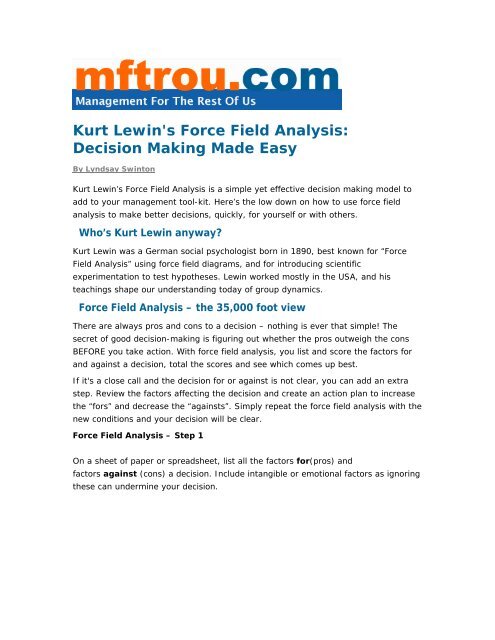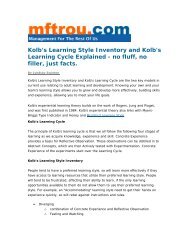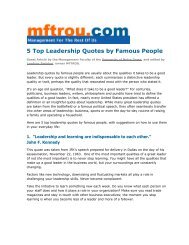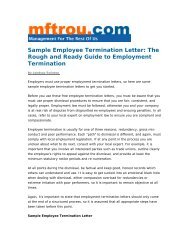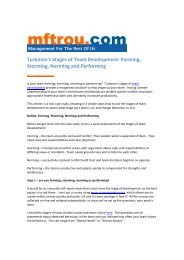Kurt Lewin's Force Field Analysis - Management for the Rest of Us
Kurt Lewin's Force Field Analysis - Management for the Rest of Us
Kurt Lewin's Force Field Analysis - Management for the Rest of Us
Create successful ePaper yourself
Turn your PDF publications into a flip-book with our unique Google optimized e-Paper software.
<strong>Kurt</strong> <strong>Lewin's</strong> <strong>Force</strong> <strong>Field</strong> <strong>Analysis</strong>:<br />
Decision Making Made Easy<br />
By Lyndsay Swinton<br />
<strong>Kurt</strong> Lewin’s <strong>Force</strong> <strong>Field</strong> <strong>Analysis</strong> is a simple yet effective decision making model to<br />
add to your management tool-kit. Here’s <strong>the</strong> low down on how to use <strong>for</strong>ce field<br />
analysis to make better decisions, quickly, <strong>for</strong> yourself or with o<strong>the</strong>rs.<br />
Who’s <strong>Kurt</strong> Lewin anyway?<br />
<strong>Kurt</strong> Lewin was a German social psychologist born in 1890, best known <strong>for</strong> “<strong>Force</strong><br />
<strong>Field</strong> <strong>Analysis</strong>” using <strong>for</strong>ce field diagrams, and <strong>for</strong> introducing scientific<br />
experimentation to test hypo<strong>the</strong>ses. Lewin worked mostly in <strong>the</strong> USA, and his<br />
teachings shape our understanding today <strong>of</strong> group dynamics.<br />
<strong>Force</strong> <strong>Field</strong> <strong>Analysis</strong> – <strong>the</strong> 35,000 foot view<br />
There are always pros and cons to a decision – nothing is ever that simple! The<br />
secret <strong>of</strong> good decision-making is figuring out whe<strong>the</strong>r <strong>the</strong> pros outweigh <strong>the</strong> cons<br />
BEFORE you take action. With <strong>for</strong>ce field analysis, you list and score <strong>the</strong> factors <strong>for</strong><br />
and against a decision, total <strong>the</strong> scores and see which comes up best.<br />
If it's a close call and <strong>the</strong> decision <strong>for</strong> or against is not clear, you can add an extra<br />
step. Review <strong>the</strong> factors affecting <strong>the</strong> decision and create an action plan to increase<br />
<strong>the</strong> “<strong>for</strong>s” and decrease <strong>the</strong> “againsts”. Simply repeat <strong>the</strong> <strong>for</strong>ce field analysis with <strong>the</strong><br />
new conditions and your decision will be clear.<br />
<strong>Force</strong> <strong>Field</strong> <strong>Analysis</strong> – Step 1<br />
On a sheet <strong>of</strong> paper or spreadsheet, list all <strong>the</strong> factors <strong>for</strong>(pros) and<br />
factors against (cons) a decision. Include intangible or emotional factors as ignoring<br />
<strong>the</strong>se can undermine your decision.
<strong>Force</strong> <strong>Field</strong> <strong>Analysis</strong> -Step 2<br />
Give each factor a score <strong>of</strong> between 1 and 5, where 1 is low or weak and 5 is high or<br />
strong. Draw opposing arrows <strong>for</strong> each factor, where <strong>the</strong> size represents <strong>the</strong> score.<br />
<strong>Force</strong> <strong>Field</strong> <strong>Analysis</strong> - Step 3<br />
Total <strong>the</strong> For and Against scores. Is <strong>the</strong> result as expected? Do your heart and head<br />
agree? If not, review briefly <strong>the</strong> factors you listed. Are <strong>the</strong>re any missing? Are less<br />
important factors overshadowing <strong>the</strong> more important factors? Are <strong>the</strong> scores<br />
realistic, and spread across <strong>the</strong> full range? Resist <strong>the</strong> temptation to fabricate <strong>the</strong><br />
results, consider changing <strong>the</strong> factors and scores and see what happens.
<strong>Force</strong> <strong>Field</strong> <strong>Analysis</strong> - Step 4 (Additional)<br />
It may be possible to increase <strong>the</strong> For score and decrease <strong>the</strong> Against score by<br />
taking appropriate action. Could a communication plan address concerns about<br />
resistance to change? Could additional training or additional resources increase <strong>the</strong><br />
likelihood <strong>of</strong> a successful change? Review <strong>the</strong> factors and decide what actions could<br />
be taken to address or enhance any challenges.<br />
Assuming <strong>the</strong>se actions take place, what would <strong>the</strong> new scores be? Go through each<br />
factor, assuming <strong>the</strong> action has been successful, and write down <strong>the</strong> new score (as<br />
step 2). Total <strong>the</strong> new For and Against scores (as step 3). Again, is <strong>the</strong> result as<br />
expected?
Crystal Clear Decisions<br />
By now your decision is clear. Although you might not like <strong>the</strong> outcome, you can be<br />
confident that your decision is sound, transparent and explainable.<br />
Instead <strong>of</strong> using “gut feel” or o<strong>the</strong>r haphazard means, try a more scientific decision<br />
making method. <strong>Kurt</strong> Lewin <strong>Force</strong> <strong>Field</strong> <strong>Analysis</strong> is simple yet effective method to<br />
improve your decision making ability today<br />
By Lyndsay Swinton<br />
Owner, <strong>Management</strong> <strong>for</strong> <strong>the</strong> <strong>Rest</strong> <strong>of</strong> <strong>Us</strong><br />
www.mftrou.com<br />
Signup <strong>for</strong> Monthly <strong>Management</strong> Tips here


